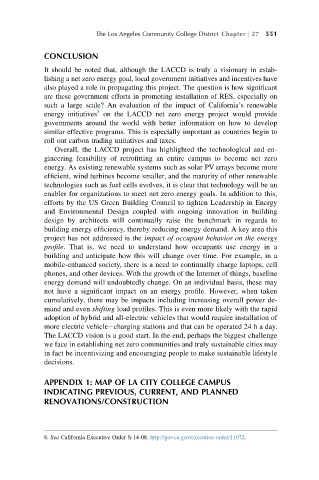Page 583 - Sustainable Cities and Communities Design Handbook
P. 583
The Los Angeles Community College District Chapter j 27 551
CONCLUSION
It should be noted that, although the LACCD is truly a visionary in estab-
lishing a net zero energy goal, local government initiatives and incentives have
also played a role in propagating this project. The question is how significant
are these government efforts in promoting installation of RES, especially on
such a large scale? An evaluation of the impact of California’s renewable
8
energy initiatives on the LACCD net zero energy project would provide
governments around the world with better information on how to develop
similar effective programs. This is especially important as countries begin to
roll out carbon trading initiatives and taxes.
Overall, the LACCD project has highlighted the technological and en-
gineering feasibility of retrofitting an entire campus to become net zero
energy. As existing renewable systems such as solar PV arrays become more
efficient, wind turbines become smaller, and the maturity of other renewable
technologies such as fuel cells evolves, it is clear that technology will be an
enabler for organizations to meet net zero energy goals. In addition to this,
efforts by the US Green Building Council to tighten Leadership in Energy
and Environmental Design coupled with ongoing innovation in building
design by architects will continually raise the benchmark in regards to
building energy efficiency, thereby reducing energy demand. A key area this
project has not addressed is the impact of occupant behavior on the energy
profile. That is, we need to understand how occupants use energy in a
building and anticipate how this will change over time. For example, in a
mobile-enhanced society, there is a need to continually charge laptops, cell
phones, and other devices. With the growth of the Internet of things, baseline
energy demand will undoubtedly change. Onanindividualbasis, these may
not have a significant impact on an energy profile. However, when taken
cumulatively, there may be impacts including increasing overall power de-
mand and even shifting load profiles. This is even more likely with the rapid
adoption of hybrid and all-electric vehicles that would require installation of
more electric vehicleecharging stations and that can be operated 24 h a day.
The LACCD vision is a good start. In the end, perhaps the biggest challenge
we face in establishing net zero communities and truly sustainable cities may
in fact be incentivizing and encouraging people to make sustainable lifestyle
decisions.
APPENDIX 1: MAP OF LA CITY COLLEGE CAMPUS
INDICATING PREVIOUS, CURRENT, AND PLANNED
RENOVATIONS/CONSTRUCTION
8. See California Executive Order S-14-08. http://gov.ca.gov/executive-order/11072.

